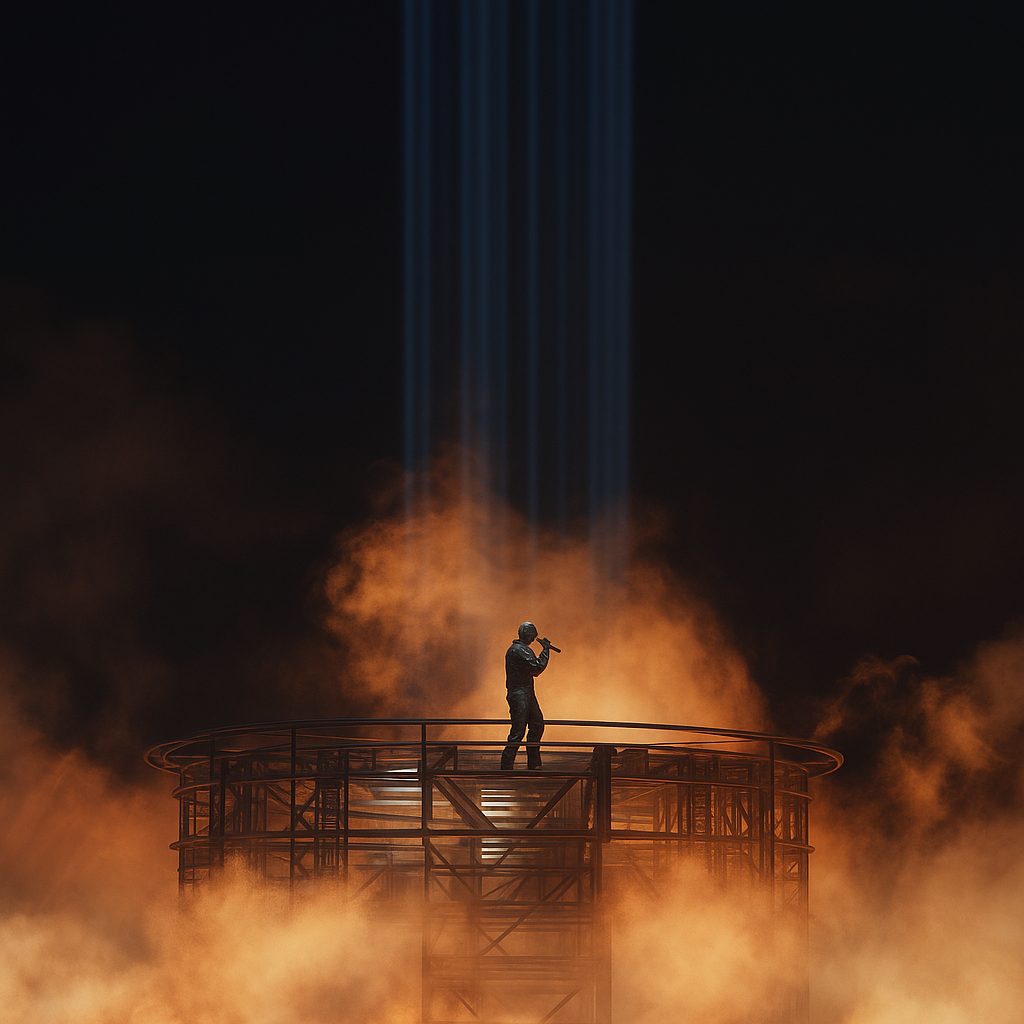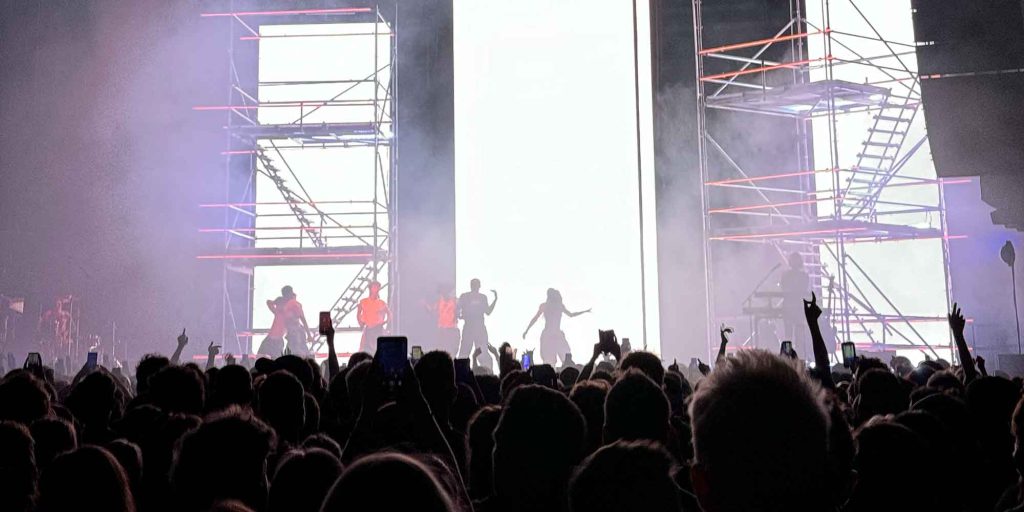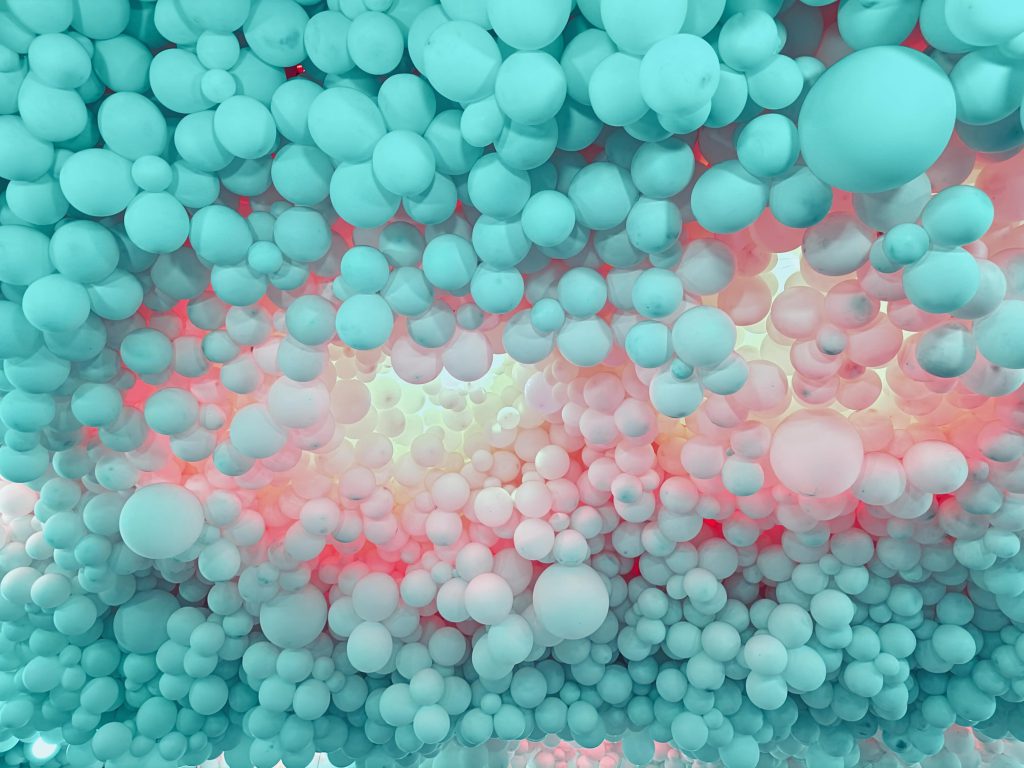The Aesthetic Engineering of Travis Scott’s Concert Worlds
What transforms a concert from a performance into an almost mythological experience? What imbues a visual moment with the power to suspend time, gripping audiences with the intensity of a dream they haven’t yet had? The experience emerges from a deeper register than familiar aesthetic categories (such as form, scale, and mood) and instead centers on how visual experience can intercept the immediate present, articulating with startling accuracy the textures and myths of modern life.
Travis Scott’s recent Coachella performance mastered this sentiment, particularly through the scenographic worlds crafted by Niklas Bildstein-Zaar and the affiliated creators of his Berlin-based studio Sub Global. These concert visuals exercise what I am going to refer to as visceral minimalism; built with architectural precision yet designed to behave like raw instincts, making audiences feel something before they can name it. Such performances transcend entertainment, holding a mirror to our contemporary psychic state through aesthetic engineering at its most sophisticated. Let’s take a closer look.
The Architecture of Instinct
At first encounter, these stages may appear brutalist: heavy, monolithic, unfinished. Yet their true power emerges from their capacity to signal urgency and emotional contradiction. The bare materials (concrete, scaffolding, smoke, steel) function as atmospheric decoration. In relation to Scott’s personal mythology, however, they are also semiotic structures: they constitute a symbolic language felt in the body before it reaches the mind.
For design studio Sub Global, architecture co-authors performance, designing relevance as its primary material. Through a potent synthesis of minimal forms and chaotic energy, these environments position audiences within a feedback loop of sensation and interpretation. The work refuses stability, shimmering instead with productive uncertainty. These shows demand a different kind of spectatorship, one that processes experience like memories or myths: in fragments, flashes, and sensations that cohere retrospectively.
This approach reflects what Bildstein-Zaar describes as “brutally forcing the audience to face their various complicities,” (source) blending architecture, sociology, and anthropology into scenographies designed for both physical and digital immersion. The aesthetic evokes connections to Balenciaga’s stark runway worlds, collaborations with artists like Anne Imhof (and her recent appearance in New York’s Park Avenue Armory: DOOM-House of Hope), and the industrial minimalism of post-apocalyptic luxury that transcends fashion to inhabit live performance.
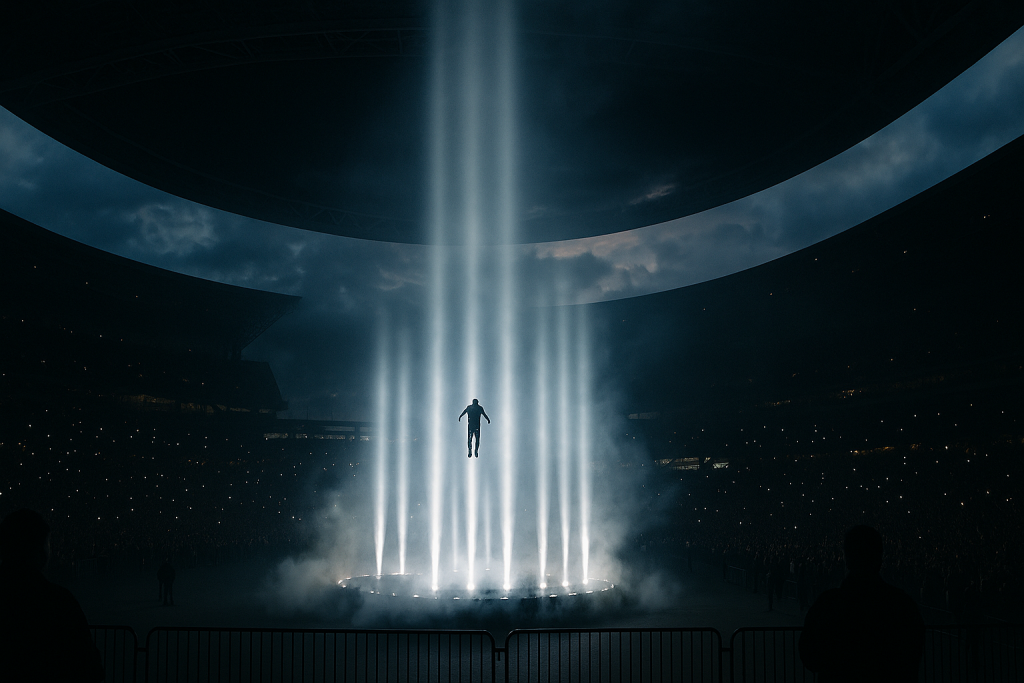
The Logic of Visceral Minimalism
What proves most striking is the deliberate sparseness of elements. A single beam of light. A void of smoke. A floating performer. These simple gestures acquire cosmic implications when scaled and timed with precision. This represents visceral minimalism at its core: design is a strategy, as symbolic language, as world-making through reduction.
Consider the transformation of basic components: massive LED walls, floating platforms, raw beams of light, and atmospheric smoke become displays of monumental visuality through strategic deployment. A solitary incandescent panel or a beam of light, deployed at precisely the right moment and multiplied thousandfold across an arena, creates something simultaneously brutalist and beautiful.
Every decision within this aesthetic ecosystem contributes to the larger narrative: a metaphysical architecture of relevance. Sub’s environments function as performance generators, shaping and creating the experience itself, track-by-track.
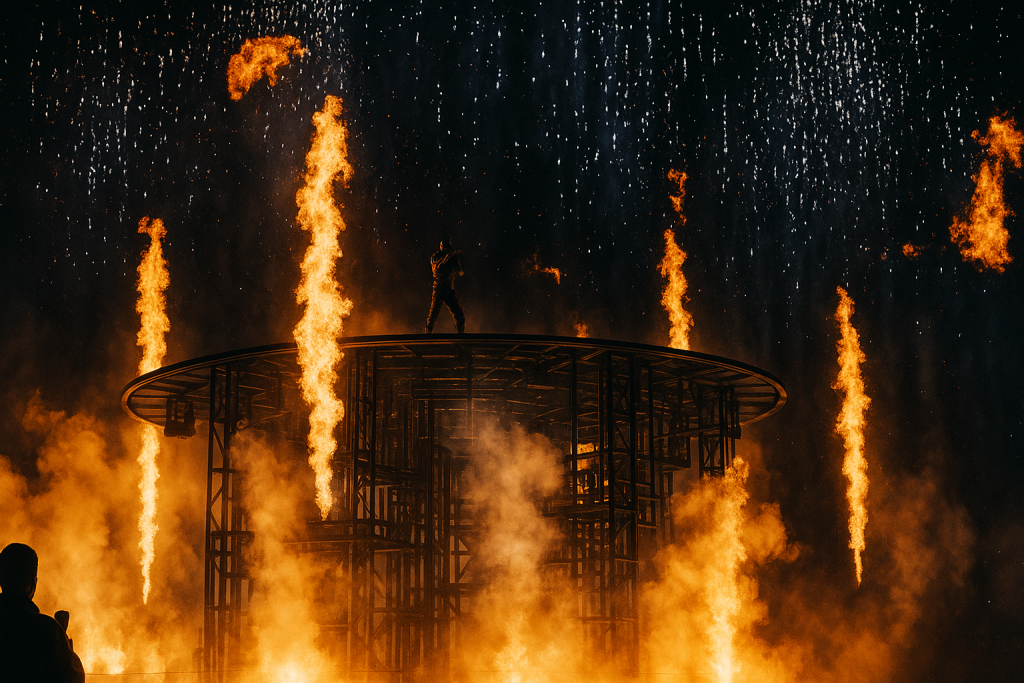
Chaos as Cultural Technology
The chaotic energy pervading these performances can be read as aesthetic flourish, but is in fact a technology of feeling. Real-time graphics, live video manipulation, unpredictable lighting; all create an atmosphere of contingency where every second might rupture into something else. This captures the rawness of lived experience, looped back into spectacle.
Yet nothing here is truly random. Beneath apparent improvisation lies intense calibration; engineered chaos that senses and steers audience perception rather than dictating it. The heavy contrast between light and shadow, visibility and obscurity, plays directly into this sense of unpredictability. Smoke becomes an active participant, blurring edges, swallowing light, amplifying drama through its inherent unpredictability.
Like any effective myth, Scott’s Coachella shows move through archetypes and atmospheres: primal light, industrial sound, cosmic scale. And audiences feel them before understanding them. The goal isn’t to present tidy narratives or flawless performances but to evoke raw, physical reactions. The stagecraft doesn’t smooth the edges; instead, it sharpens them and releases them onto viewers from all possible directions.
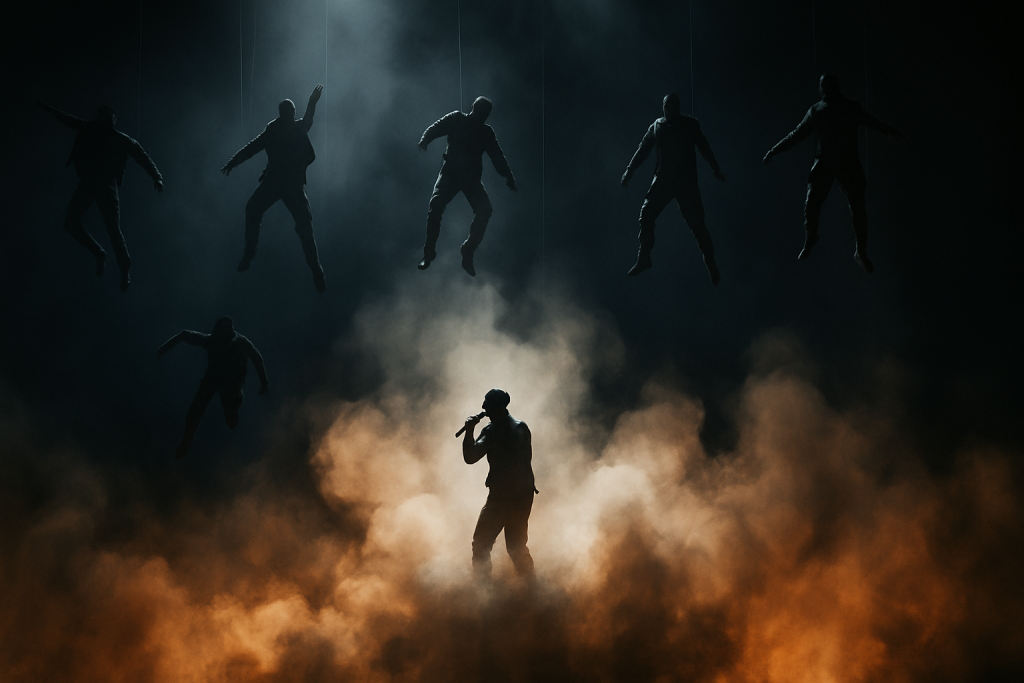
Bodies in Defiance: The Aerial Dimension
Perhaps nowhere is visceral minimalism more powerfully embodied than in the aerial choreography that punctuated Scott’s Coachella performance. As he performed tracks like “Highest in the Room,” dancers ascended into the air, remaining suspended in seemingly impossible positions: some inverted, others floating with weightless grace above the stage. Without a doubt, these “levitating dancers” added spectacle. But also, they literalized the music’s psychedelic aspirations, transforming metaphor into physical reality.
The aerial work, choreographed by Kianí del Valle and her innovative approach to genre-crossing movement, operates according to visceral minimalism’s core logic: maximum impact through essential gesture. The dancers’ weightlessness creates a surreal, almost traumatic disruption of natural law that audiences again process somatically before cognitively. This is embodied philosophy: using human forms to make visible the impossible, the transcendent, the mythic. The aerial dimension transforms the concert from horizontal spectacle to vertical revelation, literally elevating the experience into something that audiences described as “surreal” and “like part of a larger art installation.”
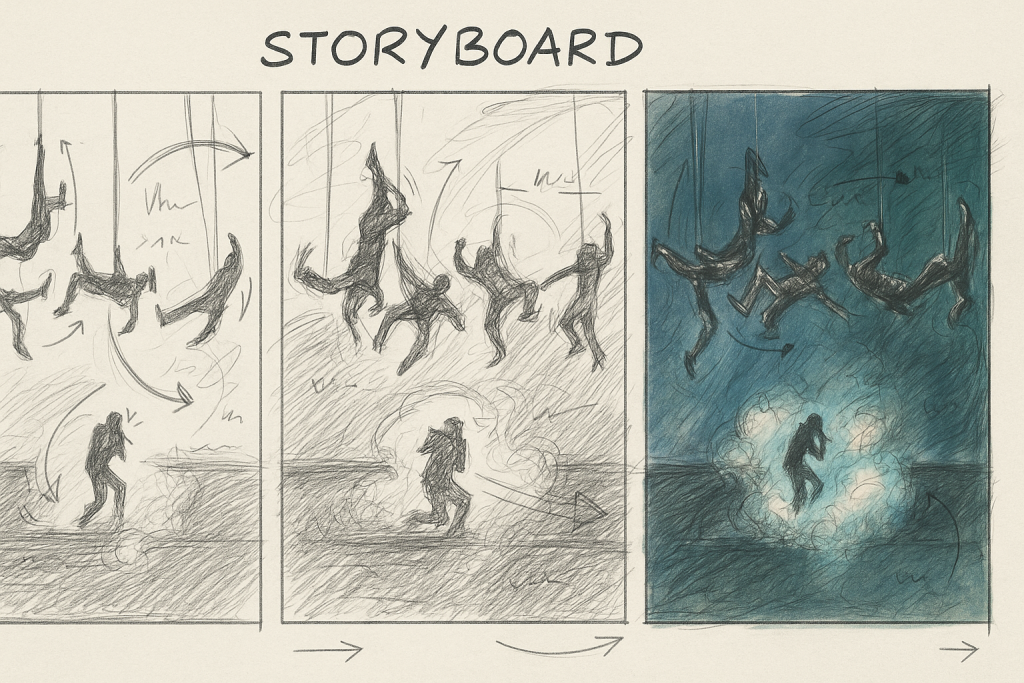
The way things look teaches us how to see
We are witnessing the return of style: not as taste or trend but as a form of knowing. Style here carries information, drawing on multiple symbolic systems: architecture, fashion, politics, performance art; and synthesizing them into something hybrid and plural. It’s a genuine symbolic synthesis, mirroring Scott’s approach to crafting alternate realities; whether through his own Astroworld mythology or his ability to blend Houston’s underground culture with mainstream spectacle into coherent experiential universes.
This is what makes these concerts feel contemporary in the truest sense. They are visually striking, but also relevant at the same time, arising from and responding to the tangled systems of culture, value, and power that define our present moment. They achieve mythological status by giving form to the invisible: to our fears, desires, and complicities.
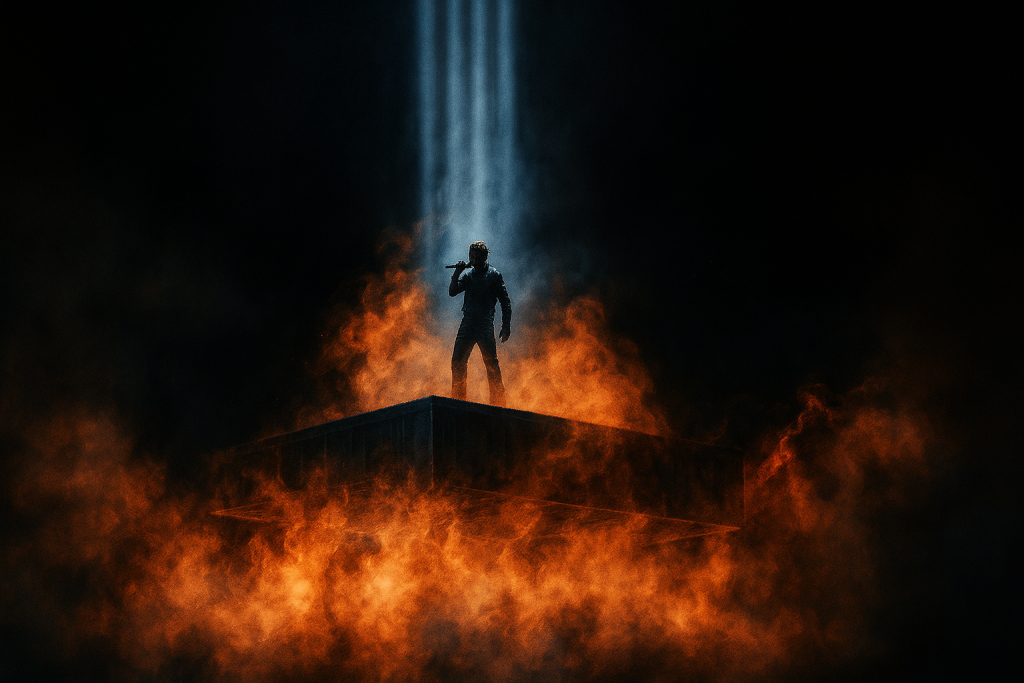
Historical Lineage: From Appia to Sub
This aesthetic engineering has a scenographic lineage that traces back to early twentieth-century visionaries like Adolphe Appia and Edward Gordon Craig, who understood light and shadow as primary elements of truth. They believed stages should transcend realism to evoke the essence of experience.
Appia revolutionized stagecraft by serving actor and music through light and space, creating dynamic environments rather than static backdrops. Similarly, Craig imagined stages as places of symbolic abstraction where suggestion mattered more than realism, where movement, light, and shadow could evoke worlds beyond the material.
Fast forward to Travis Scott’s Coachella performance and the essence of Appia’s spatiality remains: dramatic elevation, axial symmetry, and sculpted shadow. But it’s now infused with technological spectacle and a 21st-century mythology of self. Hovering performers suspended in light beams, lone figures silhouetted against towering smoke plumes, human forms dwarfed by space and elemental forces. The tension between fragility and power, chaos and control represents both a hallmark of contemporary staging and a deep connection to these early reformers’ philosophies.
Appia’s work served philosophical and spiritual themes: Wagnerian total works of art, Dantean journeys through the soul. Travis Scott’s reinterpretation, though not directly allegorical, still leverages the same visual vocabulary to stage a personal mythology: the lone artist on a journey, dwarfed by forces greater than himself (fame, anxiety, surveillance, history). Sub Global updates this historic project with today’s materials, technologies, and semiotics, but the difference is that contemporary stakes are higher: In an age of overstimulation and hyperproduction, crafting moments of focused relevance and cutting through noise requires not just aesthetic talent but deep understanding of symbolic economies.
Here, visceral minimalism emerges as a direct response to our era’s semiotic overload. Where Appia and Craig stripped away theatrical ornament to reveal essential truths, today’s practitioners must navigate an exponentially more complex symbolic landscape: one saturated with digital media, consumer imagery, and competing cultural narratives. The minimalist impulse strikes back with renewed urgency: if everything screams for attention, then silence becomes radical. If every surface is mediated, then raw concrete speaks with startling clarity. Using the century-old tools of reduction and abstraction to cut through contemporary noise pollution is a strategic deployment of this method.
It’s a lineage of theatrical sublime: one that transforms existential architecture into cultural architecture. The visceral impact emerges precisely from this collision between historical method and present necessity, creating what we might call a semiotics of scarcity in an age of abundance.

Stage Design by Adolphe Appia.

In the images I’ve generated for this post, there is a clear visual throughline:
- The human figure dwarfed by space and elemental forces: just as Appia sculpted space around the actor.
- Light beams and verticality creating monumental yet empty landscapes: reminiscent of Craig’s desire to elevate stage imagery into abstraction.
- The tension between fragility and power, chaos and control: a hallmark of modern staging but deeply rooted in these early reformers’ philosophies.
In Scott’s case, this aesthetic does not reference the past for nostalgia’s sake. Instead, it’s more about recognizing that the language of stage design continues to evolve from these core principles, because they have a philosophic core that is in line with Travis Scott’s identity formation. It’s a testament to how radical ideas can echo across time, re-emerging in new contexts with fresh urgency. At Coachella. 2025.
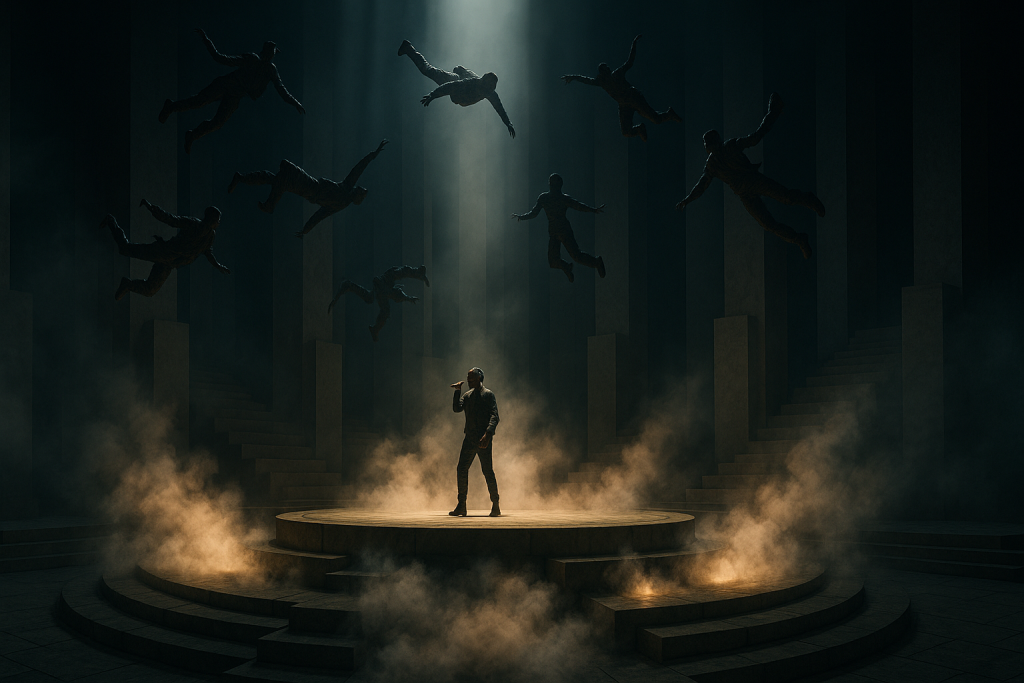
Contemporary Creative Direction for Live Entertainment: Toward A Visceral Epistemology
This work points toward a new frontier we might call metaphysical stagecraft. It’s no longer sufficient to build beautiful things. Contemporary designers, and those of the near future, must build systems of feeling, belonging, and truth. They must work at the level of intuition, not just intention, treating aesthetics as symbolic operations capable of shifting how reality is understood.
What emerges is a practice of visceral minimalism that strips stage design to essential elements while maximizing their emotional impact: embracing darkness and contrast, integrating smoke as an active design tool, using real-time visuals to build chaos and immediacy, and prioritizing audience feeling over polished precision. The combination of raw, almost primitive materials with cutting-edge technology scales everything beyond expectation while maintaining the fundamental principle that less can indeed be more: when that “less” is precisely calibrated to hit the nervous system directly.
In this sense, Scott’s performance becomes a myth-making machine: one that invents new languages for expressing the emotional structure of contemporary life. These performances aim to entertain so much as they create what one might call visceral epistemology: ways of knowing through feeling, understanding through immersion, meaning through mythic encounter.
The result is cultural design at its highest level. Not just cool shows but structured interventions in how we perceive, feel, and inhabit our present moment. This is also visceral minimalism as aesthetic engineering: transforming spectatorship into participation, observation into embodiment, entertainment into contemporary mythology through the radical power of less.
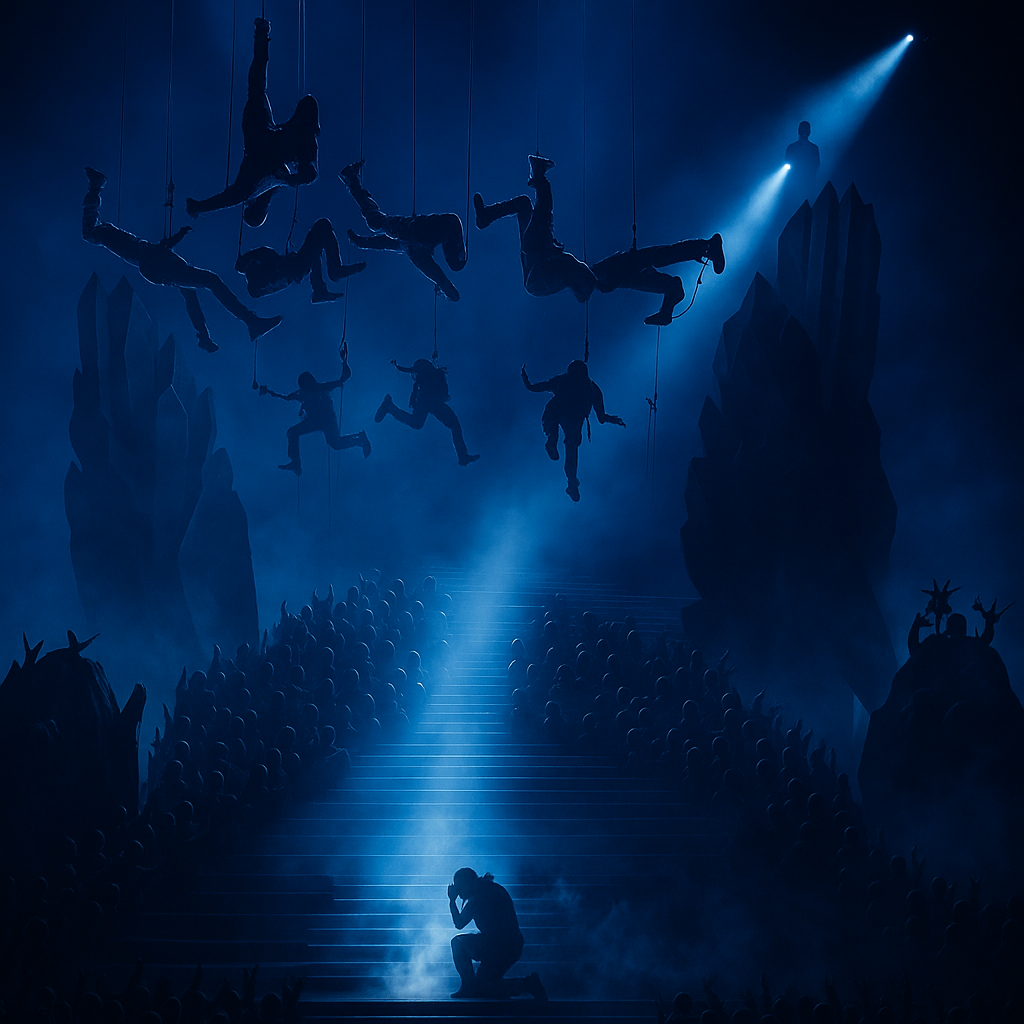
Disclaimer: I was not involved in the production of this show nor in the creative process behind this project. The reflections and visuals shared here are my own interpretations, created as part of my ongoing practice as a creative director in areas of live entertainment. This is a personal exploration aimed at better understanding the aesthetics, styles, and artistic languages of contemporary performers and their creative teams. It’s how I process, learn, and engage more deeply with the work that inspires me.
The images of this post are AI-generated interpretation, inspired by the visual aesthetics of Travis Scott’s live performances. It is not affiliated with or endorsed by the artist, his team, or the production designers. The images were created as part of a personal exploration and research into matters of stage and show design, blending contemporary concert visuals with historical scenographic influences (notably from Adolphe Appia and Edward Gordon Craig). This work is non-commercial and intended purely for educational, reflective, and artistic discussion.
